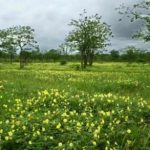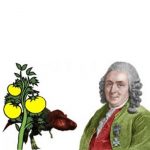TREE LIFE
May 2008
MASHONALAND CALENDAR
11 May (2nd Sunday): Extra outing. Teach yourself trees at Christon Bank.
Bernard Beekes has arranged a “teach yourself trees” meeting, which is specifically designed to follow up on our two recent outings to Christon Bank. Bernard will organize people into 3 to 6 groups depending on attendance. He will print and provide a Mashonaland tree list for each group, with the last two Christon Bank outings records highlighted. Everybody should bring whatever books and aids (especially a lens) they require.
This is an excellent opportunity to work with others and through your own efforts to get to know your trees. Mark will be in attendance to assist but will be leaving the identification to those attending.
We will meet in the car-park at 9.30 a.m.
18 May (3rd Sunday): Annual General Meeting
This year’s A.G.M. will be held at the lovely home of Jill and Andy Vaughan in Avondale. Tea and coffee will be served at 9.30 a.m. and the meeting will start at 10. After the meeting, we will have our usual botanical walk. We will explore the garden and the nursery run by Joy Chapman.
Bring your lunch and a chair, and please also bring a plate of eats to share for tea.
24 May (4th Saturday): Greendale
Our fourth Saturday walk is a return visit to the home of Rhett Butler, where we expect to see some interesting indigenous trees and plants.
We will meet at 2.30 p.m.
MATABELELAND CALENDAR
Please contact Jean Wiley or Gill Short for details of the next Matabeleland function.
CHAIRMAN’S REPORT. 2007-8. FOR THE A.G.M. ON 18 MAY 2008
I have pleasure in presenting the Chairman’s report for the year 1 April 2007 to 31 March 2008.
General
This is the seventh annual report I have presented as Chairman and, traditionally, I begin with an economic summary. It is interesting that throughout the 7-year period the main themes have largely remained the same but with the numbers and level of difficulty increasing to ever higher levels.
I notice that annual inflation was at 3-digit levels (782%) in 2006, 4-digit (2,200%) in 2007 and as I write this in early May 2008 at 6-digit levels (165,000% based on the latest February figure). Maybe it is already at 7-digit levels were the actual figures known.
Economically, things declined fast during the year. For me, the great turning point was the operation to reduce prices in June 2007 that led to dire shortages of all locally produced goods, especially food. This caused very much greater difficulties in going about our ordinary lives.
“Inappropriately denominated bank notes” were a constant and severe problem, fuel has been available but at a price outside many of our members’ budgets, bank interest rates remained negligible, and the slow and steady dollarisation of the economy continued.
Outings
Despite all this, a full schedule of 3rd Sunday outings took place. An attempt was made to restrict outings to places near to Harare in order to ease fuel costs.
The outings were as shown in the following table:
April 2007 Haka Game Park
May A.G.M. Meikles estate, Borrowdale
June Ngomakurira
July Jacana Yacht Club
August Mukuvisi Woodland
September Christon Bank
October Carli’s Farm, Arcturus
November Shenstone, Mt Hampden
December Xmas Social – Meikles estate, Borrowdale
January 2008 Mukuvisi Woodland
February Ngomakurira
March Christon Bank
Once again, I am very grateful to Meg Coates-Palgrave for leading many of these outings.
Tom Muller’s Botanic Garden walks were mainly in abeyance during the year, but we enjoyed those that did take place. We hope to re-start these most interesting walks in the near future.
During the year, Bernard Beekes very kindly took over the writing up of our monthly outings, thereby lightening my load considerably. He also organised the February Ngomakurira outing when I was unable to attend. Thank you, Bernard.
I continued to lead my 4th Saturday walks near Harare. I find I still get a lot of personal interest and satisfaction out of these.
Membership
The current membership, compared to previous years, is as follows:
MEMBERSHIP 2008 2007 2006 2005 2004
Ordinary members 94 114 127 167 159
Associate members 5 5 5 5 5
Honorary members 6 6 5 4 6
TOTAL 105 125 137 176 170
The figures show that the decline in members, which leveled off and was even slightly reversed in 2005, has resumed. Attracting new members should be a priority.
Tree Mapping
The mapping scheme continues and remains in the capable hands of Maureen Silva-Jones.
Tree Life
Bill Kinsey took over as editor of Tree Life after last year’s A.G.M. The arrangement has worked very well and has been enormously helpful to me. Thank you, Bill.
Finance
Terry will be reporting on this separately. However, the Society continues to operate by (basically) having almost no expenditure at all and relying on subscriptions and donations. We are very grateful to certain overseas members whose voluntary contributions have been most important.
Website and digitisation
The website has been very reliably maintained by Odette Lind. Furthermore, Ian Riddell has been capturing and editing back copies of Tree Life and a number of these have been placed on the Society’s website by Odette. The result, when complete, will be a full public record of the Society’s activities. Furthermore, the contents of Tree Life will be fully searchable via search engines such as Google. On behalf of the Society, I would like to thank them both for their work on this important project.
Committee
The Committee consisted of Ruth Evans (Secretary), Terry Fallon (Treasurer), Eva Keller, Richard Oulton, Mimi Rowe and myself. My sincere thanks go to all of them for their hard work and advice during the year.
The Chairmanship
Having completed seven years of Chairman of the Society, I am very happy to stand again at this A.G.M. for an eighth year. However, I do feel that this is a long time for one person to be Chairman. Furthermore, the problems tend to remain the same and I feel that it is time for a fresh mind to tackle the various challenges.
The Committee has been discussing the issue and I would urge all the members to give some thought to this question.
-Mark Hyde, Chairman
Outing to Ngomakurira 17 February 2008
Ngomakurira was last visited on 21 June last year, and the report appeared in the August 2007 issue of Tree Life, No 328
Ngomakurira, a large granite whale-back hill, lies 30 km north of Harare in the Domboshawa area (1504 m, 170 33’ 26.86” S, 310 14’ 13.79” E). Attendance at the outing was about 30. As Mark Hyde was unable to lead due to pressure of work, the outing was led by myself. We climbed the hill to the saddle, split the large group into smaller groups, dispersed across the hill, and met at a rendezvous just before lunch to correlate the tree lists.
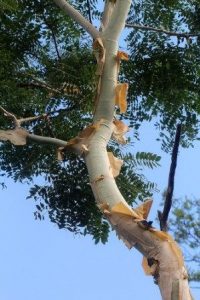
Paperbark Albizia, Albizia tanganyicensis. Photo: Bart Wursten. Source: Flora of Zimbabwe
All three of the Syzygium species that occur in the Mashonaland tree list area, Syzygium cordatum, S. guineense subsp. afromontanum and S. guineense subsp. guineense, were unusually present in this one location. Elephantorrhiza goetzei seemed to have enjoyed the heavy rainy season. The trees had a heavy crop of pods and seed. When the pods split apart, the outer case separates from the inner case. These split pods seem to shred in the wind and blow and collect in mounds, where the large heavy seed appears to have a better chance of germinating. Combretum zeyheri had a heavy crop of its large characteristic 4-winged seed.
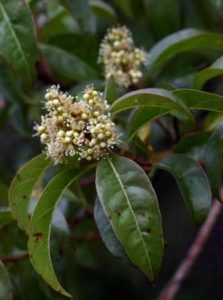
Lavender tree, Heteropyxis dehniae. Photo: Bart Wursten. Source: Flora of Zimbabwe
The Lavender tree, Heteropyxis dehniae, gets its common name from the resins contained within the leaves. Crush a leaf and smell it to experience this pleasant scent. Not only is it pleasant, but a 2003 University of Zimbabwe report revealed that essential oil extracted from H. dehniae leaves shows antimicrobial and notable cytotoxic activity. The leaves had a pleasing russet colour, and the grey bark was peeling to reveal the creamy coloured underbark. Another “peeling bark tree” was the Paperbark Albizia, Albizia tanganyicensis, with its distinctive white bark.
The African coca tree, Erythroxylum emarginatum, has some unusual leaf characteristics. Break the leaf to see the yellow latex. Crush the leaf and listen to the crackling noise. In traditional medicine, extracts from this plant are used for pain relief, increasing alertness and as an aphrodisiac. Alkaloids isolated in a 2006 Kenyan/Japanese study found that they were similar to the alkaloids from Erythroxylum coca, the South American source of cocaine.
Alphabetical list of names (56 species recorded – interestingly including no Acacias):
Albizia antunesiana; Albizia tanganyicensis; Brachylaena rotundata; Brachystegia spiciformis; Brachystegia tamarindoides; Bridelia cathartica; Burkea africana; Cassia abbreviata; Combretum molle; Combretum zeyheri; Dalbergia melanoxylon; Dichrostachys cinerea; Dodonaea viscosa; Elephantorrhiza goetzei; Englerophytum magalismontanum; Erythrina abyssinica; Erythrina latissima; Erythroxylum emarginatum; Euclea crispa; Euclea natalensis subsp. acutifolia; Euphorbia matabelensis; Faurea saligna subsp. saligna; Ficus glumosa; Ficus ingens; Ficus natalensis subsp. graniticola; Heteropyxis dehniae; Hymenodictyon floribundum; Indigofera rhynchocarpa; Julbernardia globiflora; Lannea edulis; Lannea discolor; Monotes glaber; Ochna schweinfurthiana; Olea europaea; Ozoroa insignis; Parinari curatellifolia; Pavetta schumanniana; Peltophorum africanum; Protea angolensis var. divaricata; Pseudolachnostylis maprouneifolia var. maprouneifolia; Psorospermum febrifugum; Pterocarpus angolensis; Rhoicissus tridentata; Rhus longipes; Securidaca longipedunculata; Senna singueana; Steganotaenia araliacea; Strychnos spinosa; Syzygium cordatum; Syzygium guineense subsp. afromontanum; Syzygium guineense sub guineense; Tapiphyllum velutinum; Tetradenia riparia; Uapaca kirkiana; Vitex payos and Ziziphus mucronata.
-Bernard Beekes
Outing to Christon Bank, 16 March, 2008
We last visited Christon Bank on 16th September 2007 (see the outing report in the November 2007 issue of Tree Life). This small nature reserve is about 30 km north of Harare, at an altitude of 1360 m (map reference TR 888545). The reserve is in the dissected headwaters of the Mazowe River, in steep-sided granite hill country. The day was heavily overcast, and we were all thoroughly soaked in a downpour just before lunch. Thanks to our leader, Meg Coates-Palgrave, for another good day.
With its altitude of 1360 m, this area is in the transition zone between cooler, moister Harare at about 1500 m, and the much warmer, dryer Mazowe valley. Kirkia acuminata, Pericopsis angolensis and Vernonia colorata trees at the upper altitudinal limits of their range here, are not seen in Harare.
Uapaca kirkiana is very common in the area, but not so Uapaca nitida. U. nitida leaves are small relative to U. kirkiana, and have a very long petiole. The leaves are clustered at the ends of the branches. We were very excited on the way home to see a fine U. nitida in full male flower. Clerodendrum eriophyllum was also in full flower.
Terminalia stenostachya and Terminalia mollis both occur in this area and are seen as dark-green, medium-sized trees with typical Terminalia bark. Distinguishing characteristics are: T. stenostachya leaves are elliptic and clustered at the ends of branches – hence the common name rosette-leaved terminalia. T. mollis (large-leaved terminalia) leaves are bigger, more rounded and spaced out alternately on the branches, giving the tree a much more open canopy.
Margaritaria discoidea, as we know it near Harare, is usually a small two to four meter shrubby tree with small, shiny green leaves. In the lowveld, especially in Mozambique forests, it can be a fine tree reaching heights of 20 to 50 meters. Male and female flowers are not borne on the same trees. One female tree seen among the granite rocks had the characteristic three-lobed fruit, about 10 mm across. Each capsule contained three nearly ripe seeds, about 5 mm in diameter, and each shining with a blue-green iridescence.
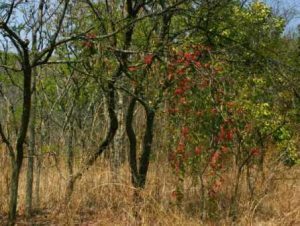
unusual mistletoe, Plicosepalus kalachariensis. Photo : Bart Wursten. Source: Flora of Zimbabwe
Near the car-park is an unusual mistletoe, Plicosepalus kalachariensis, growing on a Dichrostachys cinerea. It is unusual in that, instead of a single haustorium, this mistletoe is attached to the host tree with four or five secondary haustoria set along a branch length of about 1.5 m. An haustorium is the point of attachment of a mistletoe plant to a tree, where the mistletoe gets all of its moisture, and some of its nutrients, from the tree.
Identification of Vangueria infausta and Vangueriopsis lanciflora always seems to raise problems. A good way to learn to identify these trees is to find an area like Christon Bank where the two grow near each other and the trees and leaves can be directly compared. Key points in identification are:
• “Vangueria is hairier.” While leaves of both species are hairy, Vangueria infausta leaves are distinctly more so.
Vangueriopsis lanciflora leaf-bearing branches are stubby and red-brown/reddish in colour. Vangueria infausta branches are thinner and have only a slight reddish tinge.
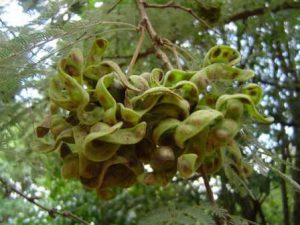
Dichrostachys cinerea pods. Photo: Bart Wursten. Source: Flora of Zimbabwe.
• Vangueriopsis lanciflora leaves appear to be less wavy and are also a much lighter green underneath.
• Vangueria infausta is often multistemmed and has a less well-defined shape. Branches of Vangueriopsis lanciflora are more or less at right angles off a single main stem.
Below is an alphabetical list of the 55 species recorded:
Brachystegia spiciformis; Brachystegia tamarindoides (glaucescens); Bridelia cathartica; Burkea africana; Cassia abbreviata; Celtis africana; Clerodendrum eriophyllum (glabrum); Combretum molle; Commiphora africana; Commiphora marlothii; Commiphora mollis; Coptosperma (Tarenna) neurophyllum; Dalbergia nitidula; Dichrostachys cinerea; Dombeya rotundifolia; Elephantorrhiza goetzei; Faurea rochetiana; Faurea saligna subsp. saligna; Ficus burkei (thonningii); Ficus glumosa; Ficus ingens; Ficus natalensis subsp. graniticola; Gymnosporia senegalensis; Hexalobus monopetalus var. obovatus; Hymenodictyon floribundum; Julbernardia globiflora; Kirkia acuminata; Lannea discolor; Margaritaria discoidea var. nitida; Monotes glaber; Ochna schweinfurthiana; Ozoroa insignis (reticulata); Pericopsis angolensis; Piliostigma thonningii; Pittosporum viridiflorum; Protea angolensis var. divaricata; Protea welwitschii; Pseudolachnostylis maprouneifolia var. maprouneifolia; Psorospermum febrifugum; Psydrax livida; Pterocarpus angolensis; Pterocarpus rotundifolius; Rhus leptodictya; Rhynchosia resinosa; Strychnos madagascariensis; Strychnos spinosa; Terminalia stenostachya; Tricalysia niamniamensis; Turraea nilotica; Uapaca kirkiana; Uapaca nitida; Vangueria infausta; Vangueriopsis lanciflora; Vernonia colorata and Zanha africana.
-Bernard Beekes
INVASIVE ALIEN PLANTS IN SOUTHERN AFRICA, PT. 3
In this third in the series on invasive aliens, Lesley Henderson discusses Asteraceae [the daisy family], one of the families of invasive alien plant species that occurs widely in southern Africa. –Ed.
The Daisies (Asteraceae)
Some 14 of the 198 (7%) species listed as declared plants in South Africa belong to the Asteraceae. These plants are all invasive and regarded as harmful to the natural resources of southern Africa.
The Big Six
Six species belonging to the tribe Eupatoriae are among the most invasive species in southern Africa and threaten the biodiversity of the region. They are:
Ageratina adenophora
Ageratina riparia
Ageratum conyzoides
Ageratum houstonianum
Campuloclinium macrocephalum
Chromolaena odorata
These species originate from tropical and subtropical America and the West Indies. They are invading savanna, grassland, forest margins and commercial plantations in South Africa, Swaziland, Mozambique and Zimbabwe. One species, Chromolaena odorata, extends further northwards to central, eastern and western Africa.
Chromolaena
Chromolaena odorata [treated at some length in Tree Life 334] is one of the most invasive plants, not only in southern Africa, but also the whole of tropical Africa and beyond to India, southeast Asia and Indonesia. It is native to Central and South America and the West Indies. It is a scrambling shrub up to 4 m or higher and forms thickets that smother other vegetation. It grows rapidly, flowers within one season and produces vast quantities of viable, windblown seeds that can also be dispersed long-distance by attaching to fur, feathers, and clothing. It can also reproduce vegetatively by producing adventitious roots where the stems touch the ground. Oils in the leaves make the plants inflammable even when green. Plants are relatively unpalatable and young shoots may contain toxic quantities of nitrate. Chromolaena is thought to have been unintentionally introduced through Durban, South Africa, during the 1940s and has spread rapidly over the past 60 years. Climatic factors limiting its spread are low rainfall and frost. Although chemical control is effective, the growth rate and spread of the plant make it impossible to contain in the long term over the large, often low-value and inaccessible, areas that it invades. Biological control, using natural enemies, is being investigated in southern Africa and is the only hope for its successful control.
Tithonia
Tithonia diversifolia, Mexican sunflower (yellow-flowered), and T. rotundifolia, red sunflower, are native to Central America, including Mexico. They are ornamental shrubs up to 3 m high with large showy flowers. T. diversifolia is annual or perennial, usually occurring at lower altitudes (0–600 m), and very common along the KwaZulu-Natal coast. T. rotundifolia is an annual, and usually occurs at moderate altitudes (600–1,400 m). They form dense stands along roadsides, riverbanks and in wasteland and can invade savanna and grassland.
Montanoa
Montanoa hibiscifolia, tree daisy, native to Central America, is a perennial shrub or small tree up to 6 m tall. It has large palmately lobed leaves and white flowers in terminal, branching inflorescences. It invades forest margins, woodland, bush clumps, roadsides and riverbanks, and is currently found mainly along the KwaZulu-Natal coast.
-Lesley Henderson Source: SABONET News 7.1: 32


